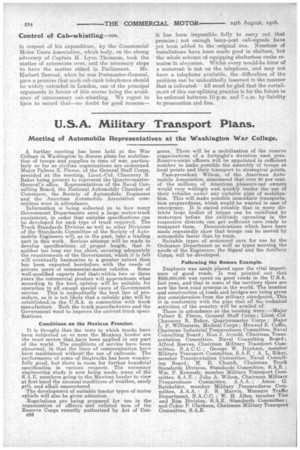U.S.A. Military Transport Plans.
Page 2

If you've noticed an error in this article please click here to report it so we can fix it.
Meeting of Automobile Representatives at the Washington War College.
A further meeting has been held at the War College in Washington to discuss plans for mobilization of troops and supplies in time of -war, particularly so far as civilian organizations are concerned. Major Palmer E. Pierce, of the General Staff Corps, presided at the meeting, Lieut.-Col. Chauncey B. Baker being present to represent the QuartermasterGeneral's office. Representatives of the Naval Consulting Board, the National Automobile Chamber of Commerce, the Society of Automobile Engineers and the American Automobile Association committees were in attendance.
Information is being collected as to how many Government Departments need a. large motor-truck equipment, in order that suitable specifications can be developed for each type of truck required. The Truck Standards Division as well as other Divisions of the Standards Committee of the Society of Automobile Engineers will, as in the past, take a leading part in this work. Serious attempt. will be made to develop specifications of proper length, that is neither too long nor too short, covering adequately the requirements of the Government, which it is felt will eventually harmonize to a greater extent than has been expected heretofore with the needs of private users of commercial-motor vehicles. Some well-qualified experts feel that' within two or three years the commercial product will approximate what according to the best, opinion will be suitable for operation in all except special cases of Government service. This is undoubtedly the best line of procedure, as it is not likely that a subsidy plan will be established; in the U.S.A. in connection with truck manufacture. Both the truck manufacturers and the Government want to improve the current truck specifications.
Conditions on the Mexican Frontier.
It is thought that the tests to which trucks have been subjected on or near the Mexican border are the most severe that,have been applied in any part of the world. The conditions of service have been abnormal, in that the lines of communication have been maintained without the use of railroads, The performance of some of the4trueks has been. wonderfully good, but there is room for further beneficial specification in various respects. The necessary engineering study is now being made, many of the S.A.E. members going to the Mexican border to view at first hand the unusual conditions of weather, sandy grit, and alkali encountered.
The development of suitable tractor types of motor vOhicle will also be given attention.
Regulalions are being prepared for use in the organization of officers and enlisted men of the Reserve Corps recently authorized by Act of Con nie
gress. There will be a mobilization of the reserve organizations of a fortnight's duration each year. Reserve-corps officers will be appointed in sufficient number. to make possible the assembly of troops at local points and their transport to strategical points. Past-president Wilson, of the American Automobile Association, announced that over 90 per cent. of the millions of American pleasure-car owners• would very willingly and quickly tender the use of their vehicles under any suitable plan of mobilization. This will make possible immediate transportation preparedness, which would be wanted in case of emergency. It is stated reliably that in many districts large bodies of troops can be mobilized by motorcars before the railroads operating in the respective districts can get sufficient cars ready to • transport them. Demonstrations which have been made repeatedly show that troops can be moved by automobile faster than by train.
Suitable types of armoured cars for use by the Ordnance Department as well as types meeting the needs of the Engineers, the Signal and the Artillery Corps, will be developed.
Following the Roman Example.
Emphasis was aeain placed upon the vital importance of good roads. It was pointed out that $225,000,000 was spent on good roads in the U.S.A. last year, and that in some of the territory there are now the best road systems in the world. The location and construction of, roads and bridges are being given due consideration:from the military standpoint. This is in conformity with the plan that all the technical activities of the country will be availed of.
Those in attendance at the meeting were :—Major Palmer E. Pierce, General Staff Corps; Lieut.-Col Chauncey B. Baker, Quartermaster Corps ; Major L. P. Williamson, Medical Corps ; Howard E. Coffin, Chairman Industrial Preparedness Committee, Naval Consulting Board ; Bion J. Arnold, Chairman Trans-. portation Committee, Naval Consulting Board; Alfred Reeves, Chairman Military Transport Committee, N.A.C.C. ; George W. Dunham, member Military Transport Committee, S.A.E. ; A. L. Riker, member Transportation Committee, Naval Consulting Board ; II. D. Church, Chairman Truck Standards Division, Standards Committee, S.A.E.; Wm, P. Kennedy, member Military Transport Committee, S.A.E.; John A. Wilson, Chairman Military Preparedness Committee, A.A.A. ; Amos G. Batchelder, member Military Preparedness Committee, A.A.A. : J. S. Marvin,, Manager Traffic Department, N.A.C.C. ; W. H. Allen, member Tire and Rim Division, S.A.E. Standards Committee ; and Coker F. Clarkson, Chairman Military Transport Committee, S.A.E.




















